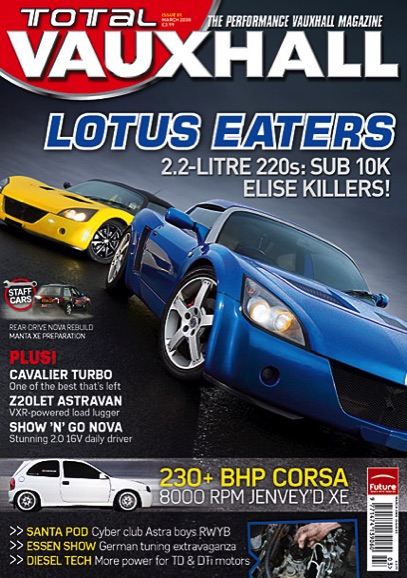
"I've just driven a two-seat convertible which handles like a Lotus Elise, goes faster than a Porsche Turbo and costs less than a Ford Mondeo.†
Its called the VX220 Turbo and even though it does 0 to 60 in four seconds and has the same chassis as the Lotus, it only costs £27,000 and unlike most cars of this type, it has an airbag, satellite navigation, anti-lock brakes and a hood which can be removed in less than two weeks. Its British too.†On the Top Gear test track, it was a sensation. One of THE most exciting and perfectly balanced cars I have EVER tried.†So who do we have to thank for this wonder car?"....read a full Clarkson Review below

Bloody Hell Fire and Holy Mother of Christ, apart from being heavier than an Elise it was a whole lot more powerful to boot. In fact, it offers up to 442BHP per tone, and at £27K nothing else for the price gets really close. A Ferrari 575, for instance, produces a figure of only 298BHP per ton, while the Lamborghini Murcielago manages 319BHP per ton.
At first you’ll wonder where the power has gone. But that’s because you’ll be changing up when the noise and vibrations become intolerable. But don’t. In fact, you change up when the blood is spurting out of your ears and your right foot has been shaken from your ankle. Then you discover where the power is.
Go there and, no matter what you happen to be driving right now, you’ll be surprised at the punch it delivers. I know I was.
What’s more, you can actually feel the suspension working. You can place this car bang on the line every time. Not just near the white line, as you would in a painfully slow Lambo or pedestrian Ferrari, but bang on that line.
I’ve always assumed that a car like this would feel like an extension of your hands and feet, but it’s the other way round. I felt like a part of it, an organic component, but a component nevertheless.
You use a normal car to take you somewhere, and it tries to make that journey as pleasant as possible. But you would never use a VX220 as a means of transport, because this is driving for the buzz of it, and as a result you’re not a passenger. You are there to do a job, which means you are no more or less important than the pistons. This is the real deal.
Everything happens because it happens, not because someone in a lab coat thinks it should happen. Jolts and acceleration are there because this is a light, powerful sports car and these are the characteristics you must expect. Clarkson
It is so difficult to write about Vauxhall's VX220 without a reference to the hallowed Lotus Elise. Both were developed by Lotus engineers and, engine aside, share a significant number of major components. On the face of it, sibling rivalry could lead to hostilities within the family. Not in this report though, as we've decided to tell you about the VX220 Turbo as if the Elise did not exist, and then in a separate article we will compare the cars, as no doubt many buyers do.
The Vauxhall VX220 (or Opel Speedster outside the UK) began life with a 2.2-litre naturally aspirated four-cylinder engine. This torquey lump provided perfectly adequate thrust, ensuring that Vauxhall's proper sportscar had apposite sportscar performance. Buyers eventually wanted more, and GM delivered the VX220 Turbo, promising to be just as light and good to drive, but with a lot more supercar-baiting performance.
Though the Turbo model received a few mild cosmetic changes (such as new alloys, subtle spoilers front and rear, and larger ducts in front of the rear wheels), these were mainly functional. Surprisingly, the shape of the VX220 has not dated at all from its 1999 show debut; it shares its 'hard points' with its Lotus brother, but maintains a unique character. Understated black paintwork may suit many buyers, but on our test car it manages to hide the detailed shape of the glass-fibre reinforced composite body panels. Only standing next to the VX220 do you appreciate how low it is, especially at the front. The headlights are set near to the ground, and nestle behind a (nearly) trapezoidal transparent cover with the indicators. The sharp lines flow up to a taut rear end, truncated by further distinctive lights (echoing the design of the front) made up of four individual circular lamps set behind a clear cover. The other talking point is the twin-exit exhaust system, arranged one atop the other for a change.
Not much has changed inside the VX, which is no bad thing. It is a small cockpit, with the driver and passenger sitting close together. The leather seats are superb, putting the driver into one of the best driving positions there is. It could be described as spartan, but remember that this sort of car is built for driver enjoyment above any other need. All controls are within easy reach of the driver, and the lovely Momo steering wheel even comes with an airbag as standard. The car is sorely lacking in oddments space for small items though. The space there is allows its contents to move around distractedly. We thought that the stepped footrest in the passenger footwell, and the stainless steel sill covers emblazoned with "Turbo" were nice additions, but sadly they are optional extras (£75 and £100 respectively).
After the car had gone back, we were shocked to discover that the cross-drilled disc brakes were also an extra (£350). In a car with the performance of the Turbo, this is penny-pinching gone too far in our eyes. The bean counters may argue that not all buyers will be so demanding on the car's brakes, but in reality do such people actually consider more extreme sportscars such as the VX220? I would be surprised if any buyer ever weighs up the VX220 against a less compromised car than say the BMW Z4. Cars such as that BMW drive well, and have earned their credentials as sportscars, but take the VX220 for a brief spin and you will understand that it resides in a very different reality.
Ownership of the Vauxhall VX220 can be likened to attacking an assault course on an army training day. Many potential recruits will give up at the first big wall to climb, in the same way that some buyers won't even be able to get into the VX. With the roof on, it is a pain in the, well, arse, neck, back and torso. You do get used to it, but it is never easy. If the roof is removed, life is far easier. Once over the high wall, it is a doddle to clamber back down the other side. In parallel, once you are seated in the leather seats, a comfortable driving position can easily be found, and everything you need is to hand.
Driving the VX220 through town is not a fraught affair. None of the controls are overly heavy, though you know you're not piloting a Corsa. The steering has no assistance, but even the guy in need of nourishment in the Mr. Muscle ads would not have a problem at parking speeds: there is little weight over the front wheels after all. The clutch and brakes have resistance, but using them will not give you an excuse to cancel your subscription to the gym. The engine is audible most of the time, though you won't need earplugs. Ruts and potholes remind you that your behind is not all that far from the tarmac as the wheels tend to crash into them at low speed.
This car is not bought to be driven at low speed. Engine warmed up; get yourself off the beaten track onto the UK's network of challenging B-roads. First time you give the turbocharger full authority over the intake air you are guaranteed to smile. The VX220 is seriously quick, by any standards. The claimed 0-60mph time is 4.7 seconds, which shades the latest Porsche 911 Carrera S as well as the iconic Honda NSX. Sprinting ability is greatly enhanced by the low 930kg kerb weight, but the figures don't tell the full story. Thanks to the addition of a turbocharger and intercooler, the VX feels quick at all times. There is negligible lag, and it even revs willingly to 7000rpm.
Sadly, we unearthed problems with the power delivery. Just when you feel the turbo coming on strong at about 2,500rpm, the wastegate opens and dumps the boost, leaving you wanting more. Keep your foot planted and the boost does build back up though, resulting in superb mid-range urge. Until you get used to this 'lull' in boost, it can be a little unnerving when overtaking, but in reality the car still accelerates hard. It is just a pity that the delivery is not more linear. We had the opportunity to speak to an engineer who had worked on the development of the Turbo and he confirmed our suspicions that the calibration is torque limited to protect the transmission. Recently, I drove the limited edition VXR220 on track and the changes releasing more power have also resulted in a more linear power curve, making the experience more enjoyable.
Despite the glitch, we still enjoyed the pace of the VX220 Turbo. In comparison to the majority of ordinary cars on the road, it is incredibly quick and agile. We did find the test car a little under damped for our liking, resulting in a reduction of pace over choppier surfaces. It was all too easy for the car to skip sideways over a series of high frequency bumps. On smoother roads, the VX excels. The steering is wonderfully communicative, though suffers from some kickback. However, the Vauxhall can be placed on the road according to your wishes, and the torque provided by the turbocharger allows you controllable and safe rear end slip in the dry, even on the public road. The flipside is a car that wants to steer from the rear in the wet, but ultimately it is still very capable in damp conditions. We didn't have the chance to try the VX on track, but I suspect it would be a complete hoot, allowing full-on power slides if desired, and enough pace and grip to keep up with the Caterham brigade.
Don't forget to order the cross-drilled brakes if you do plan on some track work. Even with hard road use, this set-up was just about up to the job in our opinions, with ABS intervention coming in a little earlier than necessary in the dry. The standard items would not be up to the demands of an enthusiastic driver.
Despite our mild irritation at the power delivery and the low level of standard equipment, take a look at the list price: £26,495 on-the-road. Even with the additional cost of the brakes, the VX220 Turbo is a conspicuous bargain sportscar. Where else can you get such a blend of thrills and performance in such a desirable package? Yes, it is compromised, but the experience is all the more rewarding for it. All you need to do now is decide if you think that the Lotus is worth the extra money...
Shane O' Donoghue - 18 Oct 2004
The Lotus from Luton:
Built by Lotus using its innovative extruded aluminium chassis technology – the basic tub was used but with a 30mm longer wheelbase and a 20mm wider rear track – the VX was powered initially by a grunty 145bhp 2.2-litre nat-asp engine, driving the rear wheels through a five-speed manual box. Weighing just 870kg, the two-seater was indecently quick, blitzing to 60mph in just 5.6 seconds and onto the wrong side of 135mph. It was also thrilling and rewarding in equal measure to punt hard and fast. That larger and wider chassis made it stable (except when on a circuit basking under Spanish summer sun, obviously); the unassisted steering was precise, accurate and feelsome; the ride quality possessed that magic Lotus quality that allowed the Vauxhall to breathe over the road; and the brakes were well up to dealing with the pace dished up by the torquey Ecotec engine. Even the slightly sloppy long-throw gearshift quality couldn't detract from the car's all-round brilliance. And it looked superb. I know beauty is in the eye of the beholder, but I loved the VX's chiselled and edgy looks. It was a dramatic car in every sense. And it was, without doubt, a significantly better car than a contemporary Elise.
The 197bhp 2.0-litre Turbo arrived after two years and turned everything up to 11. It was a devastating weapon that would laugh in the face of an M3, wee-wee all over an Evo VII and show a 911 the back door. All this from a car with a Vauxhall badge.
And yet the VX220 had none of the cachet that any rabidly quick supercar-slayer should have. Purists derided its lack of kudos and heritage, while adventurous TT, MX-5 and Z4 owners found it too raw and compromised. Two difficult stools between which to fall. Which is why it's a brilliant second-hand buy, the perfect underdog, and my favourite Vauxhall to date. By Ben Whitworth.
EVO Vauxhall VX220 Turbo
f there's a downside to the motor industry's current fixation with power outputs, it's that once you've experienced the punch of a 250bhp hot hatch or 300bhp rally-spawned slingshot, opening the taps in a low-powered, lightweight sports car such as the Vauxhall VX220 or Lotus Elise is, frankly, a bit underwhelming. Heresy, I know, for on a lightly trafficked country road such finely honed sports cars deliver a rarefied, cerebral driving experience. But when a raft of equally tempting and no doubt more practical sub-√‚£30K alternatives vie for your attention with vivid slugs of instant accelerative gratification, dynamic dumbing-down has never been so tempting.
Fortunately for those of us who are easily corrupted, salvation is at hand in the form of Vauxhall's VX220 Turbo. Combining the deft agility of a pure-bred mid-engined sports car with the honest-to-goodness wallop of the best part of 200 turbocharged brake horsepower and 184lb ft of torque, the VXT now has the potential to provide as much stimulation between the corners as it does through them, hitting 60mph in 4+sec, 100mph in 12sec and a top speed of more than 150mph. As a certain John Simister of this parish might put it, cake is both possessed and consumed.
Despite the fact the VX now has the power-to-weight ratio of a 911 turbo, I've got reservations about a turbocharged engine in a car that was originally the product of a minimalist, less-is-more mindset. Total immediacy characterises cars like this, an all-pervading urgency that courses through their control surfaces as though oiled with adrenaline. Power alone isn't the issue. That's why small(ish), normally-aspirated four-cylinder engines are perfectly suited to the application, being light, compact and responsive. Turbocharged engines are softer in their delivery and, despite huge engineering advances, inevitably blighted by some lag, which would seem the antithesis of such an intrinsically alert package. The upside, of course, is a 35 per cent power boost, which delivers vastly increased performance. Whether the delicate dynamics are swamped by such a torrent of power and torque is what we've come to find out.
Thoughtfully, Vauxhall has structured the VXT's launch by splitting it into two distinct halves: an afternoon's lappery at the Circuit de Catalunya, followed by a morning spent exploring the mountain roads that form sections of the Catalunya Rally. Both elements are vital to get a complete picture of the VXT, for few showroom-standard road cars promise to strike a more effective balance between the polarised demands of road and track use.
Unfortunately for us, the rain in Spain is falling mainly on the race track, and the temperature is more reminiscent of Birmingham than Barcelona. All of which means the circuit is more slippery than Tony Blair at prime minister's question time. Even Vauxhall's BTCC ace Yvan Muller - a genius ice racer, don't forget - reckons the track conditions are treacherous. Consequently there's little hope of learning anything meaningful, but with a phalanx of fuelled VXTs filling the pitlane and the call of a near-empty racetrack, it seems rude not to slither around for a few laps.
It's been a while since I've driven a VX220, or adopted the necessary bodily contortions required to drop the generously-padded Meaden posterior into the thinly-cushioned driver's seat. Despite an attempt at providing a few creature comforts, the VXT's bare aluminium interior is about as welcoming as a prison cell. The miserable weather isn't helping, but it's a timely reminder that you'd need serious commitment to treat one as a year-round proposition. In pure driving position terms though, it's spot-on.
As we'd been warned, the corners are unbelievably greasy. With so much torque available at so few revs, the merest tickle of throttle gets the rear wheels slewing, even in third gear, and the masking effect of the turbo disguises the swell of motive force so effectively that the tail is often sliding before you register a loss of traction. Extreme caution is the watchword, at least until you've got a feel for modulating the power and applying some pre-emptive steering correction. Exercise some self-control, treat it with respect and the VXT proves to be surprisingly benign given its mid-engined layout. However, any thoughts of genuinely pressing-on are soon abandoned, for the conditions are scarily unforgiving. One ill-timed sneeze and you'd be in the barriers for sure.
The next day dawns dull but dry, which is great as we want to pitch the VXT against some of the toughest tarmac in Europe. After surviving a hair-raising chase through the Barcelona rush hour, we are soon amongst the pine trees, switchback bends and graffiti-scrawled armco of the Catalunya Rally stages. Scrolling away before us in true PlayStation 2 style, the road jinks and swoops like a ground-hugging rollercoaster, following every contour like a second skin. We're high enough to feel the bite of frost in the air, and the road bears the scars of repeated hard winters. We're only an hour from the racetrack but these gnarly roads are a million miles from the silky, manicured asphalt of the circuit.
As you'd expect, the compact, nimble VXT is in its element, slicing through corners like a surgeon's scalpel. The unassisted steering is perfectly weighted, the gearshift pleasingly notchy and mechanical (not to mention more positive than the Elise's stringy, disconnected shift), and the ABS-equipped brakes bite hard in the first few centimetres of pedal travel. The spring and damper rates have been increased front and rear, but there's still enough body-roll to tell you when you've got the car working, and enough pliancy for the car to soak up bumps and lateral ridges. There's less transmission of road noise and vibration through the car's structure too, which adds to the sense of intimacy with what matters and isolation from what doesn't. It's a class act.
The front-end generates enormous amounts of grip, which fills you with confidence to attack every turn. The tail matches it for adhesive quality, and the balance feels wonderfully neutral and adjustable. You immediately know when you're nudging the limit of the front Bridgestones and instinctively sense how much you need to come off the throttle and the amount of lock to unwind to get things precisely back on line. Precision is the key word here, for you drive this car in a heightened state of awareness, interpreting the constant stream of information from the steering through your fingertips as though the car is feeding you Braille pace notes.
While this is also true of the basic VX220, the VXT's increased muscularity serves only to make it feel more alive, speeding its metabolic rate. Where the normally-aspirated car's chassis revels under the loading generated in the committed charge from turn-in to apex, only to fade as the modest power on tap fails to replace neck-straining lateral g with the kidney-squeezing longitudinal forces of acceleration, the VXT combines that precision and delicacy with sheer grunt, enabling you to maintain the chassis loading for longer as you capitalise on entry speed by firing it from the mid-point to the exit.
The VX220 Turbo is a uniquely exciting experience: an inspired union of sports car agility and exploitability spliced with quasi-supercar shove. All it lacks is the soundtrack to match, but that's just nit-picking. Put simply, you won't find another new √‚£25K car to touch it. EVO



....It was a devastating weapon that would laugh in the face of an M3, wee-wee all over an Evo VII and show a 911 the back door....
...The VX220 is seriously quick, by any standards. The claimed 0-60mph time is 4.7 seconds, which shades the latest Porsche 911 Carrera S as well as the iconic Honda NSX. Sprinting ability is greatly enhanced by the low 930kg kerb weight, but the figures don't tell the full story. Thanks to the addition of a turbocharger and intercooler, the VX feels quick at all times....
VX220 TURBO REVIEWS PAGE


